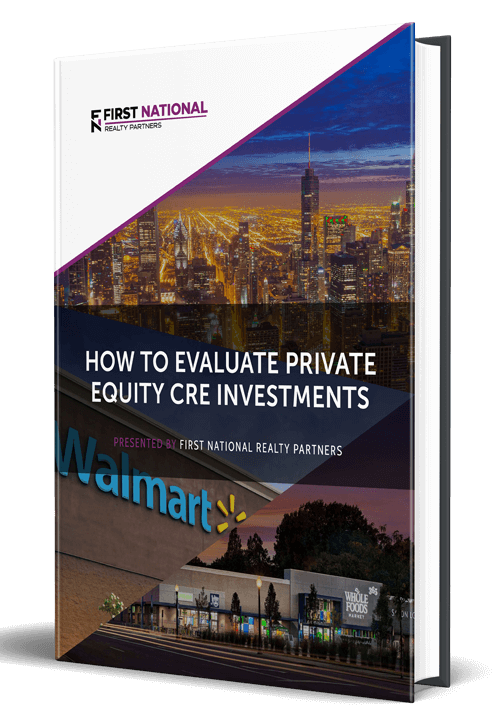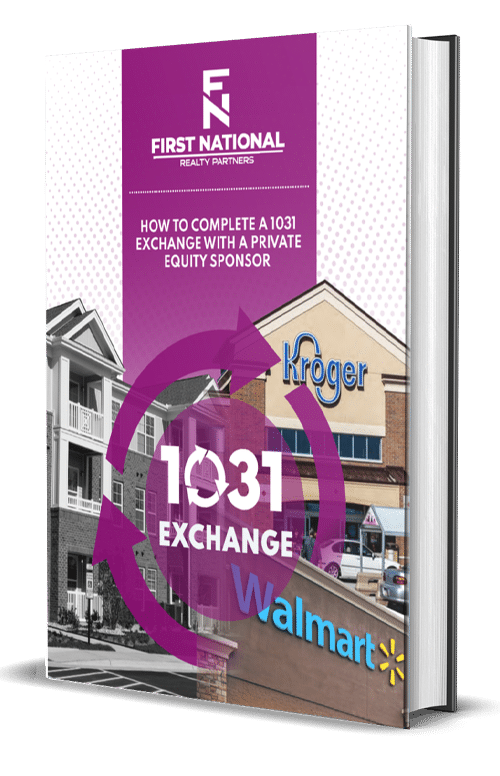When evaluating a commercial real estate investment, there are a handful of metrics that are absolutely critical to understanding the current and/or future return potential of the property. One of, if not the, most important metric is a property’s net operating income (NOI).
In this article, we will describe what Net Operating Income is, how it is calculated, why it matters, and when to use it. By the end, readers will be able to calculate Net Operating Income on their own and use it to estimate their potential return on a commercial real estate investment.
At First National Realty Partners, we specialize in the acquisition and management of grocery store anchored commercial properties. If you are an accredited investor and would like to learn more about our current investment opportunities, click here.
What is Net Operating Income (NOI)?
Net Operating Income is a commercial real estate property performance metric that measures the profitability/efficiency of an investment property’s operating performance.
The amount of Net Operating Income produced by a property forms the basis for its market value – the more NOI it produces, the more valuable it is. For this reason, it is one of the most closely watched metrics in a commercial real estate investment.
Net Operating Income Formula
The formula used to calculate NOI is simple, but choosing which line items to include/exclude can be a bit more complex. The formula is: Net Operating Income = Gross Income – Operating Expenses
Now, let’s look at which income statement line items are included in each component of this calculation.
Income Included in The NOI Calculation
The income component is the easiest to calculate because it includes just three line items:
- Gross Rental Income: The amount of money collected from tenants on a monthly/annual basis in the form of rental payments.
- Other Income: The amount of money collected from non-rental income sources like fees or interest.
- Vacancy Losses: The amount of income lost due to vacant units, expressed as a negative number.
When these three sources are combined, the result is a gross income figure that represents the first argument in the NOI formula.
Expenses Included in NOI
From Gross Income, a number of operating expenses are subtracted to get to NOI. Although each property and proforma are slightly different, the following expense line items are generally included as part of the operating expense argument.
Property Management Fees
Property management fees are costs associated with the day to day management of a property’s operations. Property Management activities could be handled by a third party vendor or by the property owner themselves.
Maintenance
Maintenance costs are those associated with the normal, every day repairs that are necessary to keep a property in good working order. This could include things like painting, landscaping maintenance, or window washing.
Legal Fees
When a tenant has to be evicted or when a rental property owner has to defend themselves against some sort of legal issue, they may incur legal fees.
Utilities
Utilities are the costs associated with using key services like water, electricity, or waste removal. Utilities can be especially tricky in the NOI calculation because some portion of them may be paid by tenants directly (if a property is sub metered) and some portion may be paid by the property owner. Only those paid by the property owner should be included as an expense in the NOI calculation.
Property Taxes
Property taxes are the cost assessed by the local city/municipality for the use of their services like trash pickup or water. When estimating NOI, it is normal for property taxes to make a big jump in the first year of ownership when a property’s value is re-assessed. After the jump, taxes tend to rise slowly each year.
Property Insurance
To protect against loss from unforeseen events like a storm, fire, or flood, commercial properties carry one or more types of insurance. The costs associated with the annual premiums are included in the insurance expense line item.
Depreciation
Depreciation is an accounting concept that allows property owners to expense a portion of the value of the property each year to account for its physical deterioration. This line item can also be tricky because it is a non-cash expense, but it is usually included as a line item in the NOI calculation, but may be added back for performance calculations.
Expenses Not Included in NOI
There are three common expense line items not usually included in the NOI calculation because they are not associated with operating the property on a day to day basis.
Income Taxes
Taxes are charged based on the amount of income a property produces, but they are not associated with its daily operations. As such, they are not included in the NOI calculation.
Tenant Improvements
Tenant improvement costs are those associated with tenant upgrades that go above and beyond day to day maintenance. For example, common tenant improvement costs include new fixtures, new appliances, or new finishes.
Capital Expenditures
Capital expenditures are those associated with large ticket property upgrades. These could include things like a new roof, new air handling system, or resurfaced parking lot. These are large expenses that are reserved for years in advance and not part of day to day operations.
Final Result
When total operating expenses are subtracted from gross income, the result is a net operating income figure that provides investors with a clue about the efficiency of a property’s operations. Each property is unique, but a very general target for a well run property is NOI that is ~45% – 50% of gross income.
For example, if a property had $100,000 in gross income, a normal NOI figure would be in the range of $45,000 – $50,000. This final result is an important input into some of the most important performance/profitability calculations.
How to Use NOI In Other Calculations
There are four important real estate return metrics for which NOI is a key input, either directly or indirectly.
Capitalization Rate
The capitalization rate, cap rate for short, is a metric that informs investors of their potential annual rate of return if the property was purchased with cash. The formula used to calculate the cap rate is: Net Operating Income / Property Value or Purchase Price.
For example, if a property had $100,000 in NOI and a value of $1,000,000, the resulting cap rate is 10%. In this transaction, investors could expect an annual return of 10% on a cash purchase. Higher when debt is added.
Debt Service Coverage Ratio
A real estate asset’s debt service coverage ratio (DSCR) is a measure of the ratio between NOI and the required debt service payments. Or, put another way, it measures how well NOI covers the loan payments. The formula used to calculate the DSCR is: Net Operating Income / Debt Service or Mortgage Payments.
For example, if a property had $100,000 in NOI and $75,000 in annual loan payments, the resulting DSCR would be 1.33X.
DSCR is particularly important when looking for debt because many lenders have a minimum requirement that must be met in order to approve the loan. In most cases, it is in the range of 1.15X – 1.25X depending on the property, leasing activity, occupancy, cash flow, and location.
Return on Investment/Cash on Cash Return
For the purpose of this article, we will use Return on Investment and Cash on Cash Return interchangeably. This metric is meant to tell investors how much they are earning on their cash investment on an annual basis. The formula used to calculate this metric is: Annual Pre-Tax Income / Total Cash Invested.
In this case, NOI is not a direct input, rather it is indirect. When debt service is subtracted from a property’s NOI, the result is pre-tax income. So, if a property had NOI of $100,000 and debt service of $75,000, annual pre-tax income would be $25,000.
Now, if an investor committed $500,000 in capital to this property, the annual cash on cash return would be 5% ($25,000 / $500,000). Generally, real estate investors like to see an annual cash on cash return in the range of 5% – 10%. More is better.
When to Use NOI
NOI is an important real estate metric during all phases of an investment’s lifecycle, but it is particularly so during the pre-investment due diligence phase.
When an individual (or firm) evaluates a potential new investment, one of the first things that they do is to look at a property’s historical performance and use it to inform the creation of a pro forma projection of future income and expenses (and NOI). Often, entire investment decisions are based on the pro forma NOI and the resulting profitability metrics.
Pros and Cons of Using NOI in Investment Calculations
From a real estate due diligence standpoint, there are pros and cons to calculating NOI as part of the due diligence/decision making process.
The major benefit is that it can provide investors with insight about potential returns, which can help with financing planning and capital allocation decisions.
But, the major drawback to using NOI in the due diligence process is that it is just an estimate. Although it is informed by historical performance, the actual performance of a property can vary (for better or worse) once it is purchased. For this reason, real estate investors should not consider proforma NOI to be an exact number. Instead, they should consider it to be “directional” and should consider multiple return scenarios where it actually turns out to be higher or lower.
Improving NOI
Net Operating Income is not a static figure. In fact, a “value-add” investment strategy – like the one we use – is predicated upon buying a property at a good price and then implementing a series of initiatives to improve NOI. Although the individual initiatives can vary, they all have the same goal which is to improve NOI by increasing a property’s income, decreasing expenses, or both.
From an investment standpoint, successfully increasing NOI can have significant implications for profitability and market value. At a 7% cap rate, every $1 in additional NOI translates to a $14 increase in the value of a property.
Net Operating Income vs EBITDA
NOI and EBITDA are both measures of operating performance, but there is a key difference that investors should be aware of.
As described above, NOI is calculated as gross income less operating costs, which include depreciation and amortization. Because these are non-cash expenses, they may not always give investors a completely accurate picture of the cash moving through the property.
EBITDA is an acronym that stands for “Earnings Before Interest, Taxes, Depreciation, and Amortization.” Essentially, it is calculated by starting with operating income and adding back each of these line item costs to get to a more representative cash figure.
Net Income vs. Net Operating Income
Net Income and Net Operating Income are two real estate metrics that are often confused for each other. The key difference between the two is that net operating income is meant to express income on an operating basis only. From this figure, non-operating costs like debt service are subtracted to get to a true net income figure, which is to say that it is net of all costs, not just those associated with operations.
Summary of Net Operating Income
Net Operating Income is a commercial real estate performance metric that measures a property’s operating performance. It is calculated as gross income less operating expenses.
Income includes rental income, vacancy loss, and other income from things like parking fees or vending machines. Line item expenses include things like property taxes, insurance, maintenance, and utilities. Income taxes, capital expenditures, and tenant improvements are not included.
One of the reasons that NOI is important is that it serves as an input into other property performance metrics like the cap rate, debt service coverage ratio, and cash on cash return.
From an investment analysis standpoint, NOI is usually calculated on a “proforma” basis, meaning prior to property purchase. As such, it is just an estimate and should not be assumed to be an exact number.
Interested In Learning More
First National Realty Partners is one of the country’s leading private equity commercial real estate investment firms. We leverage decades of expertise and available liquidity to find world-class, multi-tenanted assets below intrinsic value. In doing so, we seek to create superior long-term, risk-adjusted returns for our investors while creating strong economic assets for the communities we invest in.
When evaluating acquisitions on behalf of our investors, we carefully evaluate a property’s existing and potential net operating income as part of our pre-purchase due diligence program. Through this evaluation, we develop a value-add business plan for the property and begin to execute it immediately after the transaction closes.
If you are an Accredited Investor and would like to learn more about our investment opportunities, contact us at (800) 605-4966 or info@fnrpusa.com for more information.






